West Bay Woodturners Newsletter is a monthly update on the club activities. This free resource is available to beginner and professional woodturners.
Next Meeting
Wednesday, August 20, 2025,
Cuesta Park, Mountain View.
From 4 pm to 8 pm.
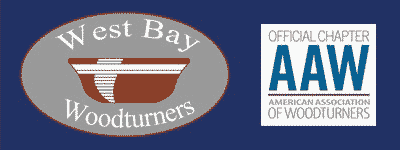
Program
August: The joint SVW/WBW annual picnic will be held on August 20, 2025, at Cuesta Park, Mountain View.

We invite all woodturners to get creative and turn their own plates or cups to enjoy at the picnic. Don’t worry if you can’t; we’ll also have paper/plastic plates and utensils available for those who need them.
President’s challenge
Jim Koren did a great job arranging for Bob Bley to lead a hands on demo of stone inlay techniques. So the next president’s challenge will be “Turned Item with Inlay – Extra Credit for Stone”.
Upcoming Meetings and Demos
- September: TBD
President’s Message
The July meeting was one of the most active and well attended I have seen since joining WBW seven years ago. Not only did we have a great presentation by Laura Rhodes on her home built spring-pole lathe, but several of our members, James Craig, Edgar Whipple, and Nate Seagraves, setup their laser engravers and offered to create name tags for some of our members. It was also great to see quite a few guests attend.
All this reminds me that this club is not “owned” by any one member, but is truly the sum of contributions from all of its members. Collective I think we can all agree that our passion for woodturning is amplified by our fellow club members.
I am looking forward to enjoying our picnic this month. Hope to see you there!
Jon Bishop
WBW President
Last Meeting Review
Wednesday July 16, 2025
Woodturners newsletter notes by Laura Rhodes, pictures by Angela Gunn and Roman Chernikov
Announcements
- We had many guests including: Katie; John; Jeanna; Eva; Becky; Camilla; Tom. Several of these are Tina’s turning students at the Palo Alto Adult School.
- Roman Chernikov announced that a Zoom session on how to use WordPress is coming soon. Roman also had extra pins available for name tags.
- Angela Gunn reported on the visit by several club members to Cancer CarePoint to deliver the wig stands. A total of 16 wig stands, created by members of WBW and SVW, were donated. If anyone makes additional stands during the year, David Vannier can take them to Cancer CarePoint for donation.
- Dean Caudle reported on the upcoming demo on Saturday, September 20 with Mark Gardner. The demo will be at Maker Nexus and the entry fee is $30/member. Mark will be demonstrating sculpture, vessels, texturing, and stepped rims. There will be a flyer with a link to an online RSVP coming soon. It is possible that there might be an opportunity for individual hands-on lessons available on Sunday with Mark.
- The annual joint WBW and SVR picnic will be on Wednesday, August 20 at Cuesta Park in Mountain View. Start time is tentatively scheduled for 4pm. WBW is hosting. We will have a best in show contest, so bring your proudest piece. All votes will be anonymous.
- James Craig brought in lots of wood, free for the taking.
- Jerry Galli has pen kits available for those wishing to contribute to the Pens for the Troops project.
Program – Demonstration of a spring-pole lathe by Laura Rhodes:
Laura Rhodes demonstrated turning with her homemade spring pole lathe. Before the live portion of the demo, she gave a slide presentation with a brief history of turning. People used lathes beginning thousands of years ago – the lathes are lost to time but turned objects remain. It is believed that most of the early lathes operated using reciprocal action – the cutting action only happening during the half of the cycle when the piece turned toward the turner’s tool. An Egyptian tomb from 300 B.C. shows two men operating a lathe – a strap around the turned work is alternately pulled in each direction by one operator while the other yield the turning tool. The Romans had reciprocal lathes turned by bows. In the Middle Ages, lathes emerged where the reciprocal return action is provided by the spring action of a bent wooden pole. With improved technology, continuous motion lathes were developed, allowing continuous rather than interrupted cutting action. At first these lathes were operated by hand or treadle. Later improvements allowed the lathe to turn with energy from water wheels, steam engines, and, later, electric motors. Nowadays, most wood lathes use variable speed electric motors.
Perhaps the most famous pole lathe turners were the bodgers who formed part of the Windsor chair industry in High Wycombe in England in the nineteenth and early twentieth centuries. The bodgers made the legs and the stretchers for the chairs. They set up temporary woodshops in the woodlands. Using a relatively small tool set, they felled the trees, sawed them into billet lengths for chair legs, split the billets using wedges, did preliminary shaping with ax and drawknife, and did the final shaping using a pole lathe. The chair legs were sold to the chair factories for final assembly.
Laura built her lathe in the summer of 2021 using mainly 2×10 Douglas Fir construction lumber. Hand tools were used for the construction. Her lathe is based on a design published by Roy Underhill in Popular Woodworking, issue #226, August 2016. Roy adapted his design from a German technical dictionary. Laura made some changes to Roy’s design based on improvements suggested by Shannon Rogers in his HandTool School online woodworking course and by James Wright on his YouTube channel, Wood by Wright.
The entire lathe is transported disassembled. Laura put it together just prior to the demo with the help of Jerry Galli. The frame uprights fit into the feet with dual tenons. The cross-members are held firmly in the uprights using tusk tenons with wedges. Two broom handles form the double spring pole. The end of the upper pole is connected to the short end of the rocker arm with a steel cable. Paracord is connected to the long end of the rocker arm, wraps around the workpiece and then goes down to the treadle. The work turns around two live centers – one inserted into the fixed headstock end, the other in a moveable poppet which is held in place with a wedge. As one steps on the treadle, the work spins toward the operator, the long end of the rocker arm goes down, the short end of the rocker arm goes up, bending the spring pole. When the treadle is released, the action is reversed – the spring pole returns to its unbent position pulling down on the short end of the rocker arm, raising the other end, pulling on the paracord, spinning the workpiece back to its original rotational position. Cutting only happens during the first part of the cycle. For spindle turning on the pole lathe, the tools are like those used in modern spindle turning – roughing gouge, spindle gouges, skew chisel. One addition is a wide flat chisel used bevel down for smoothing. A few brave club members, Jon Bishop, Bob Bley and Kevin Lee, gave the pole lathe a try.
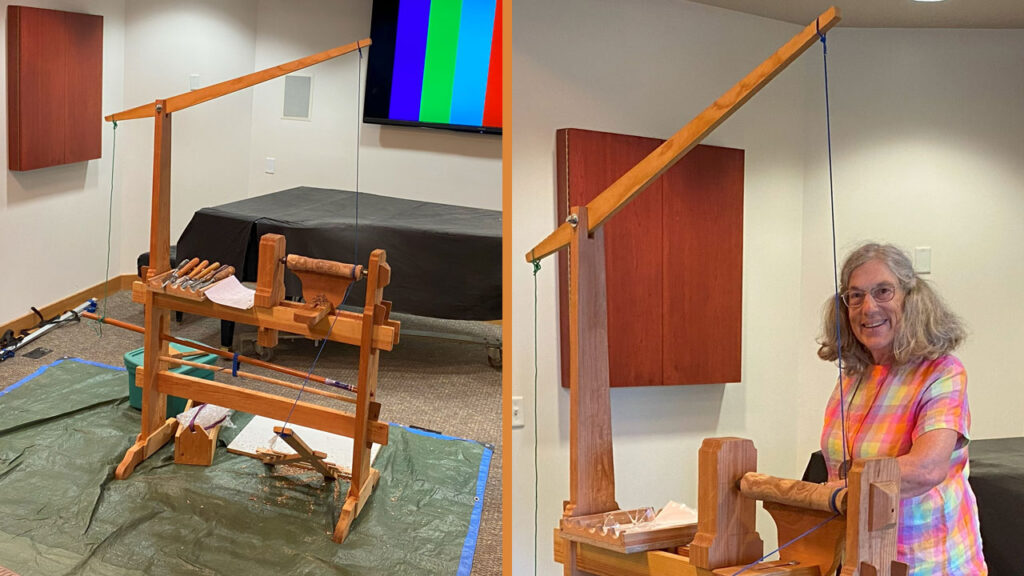

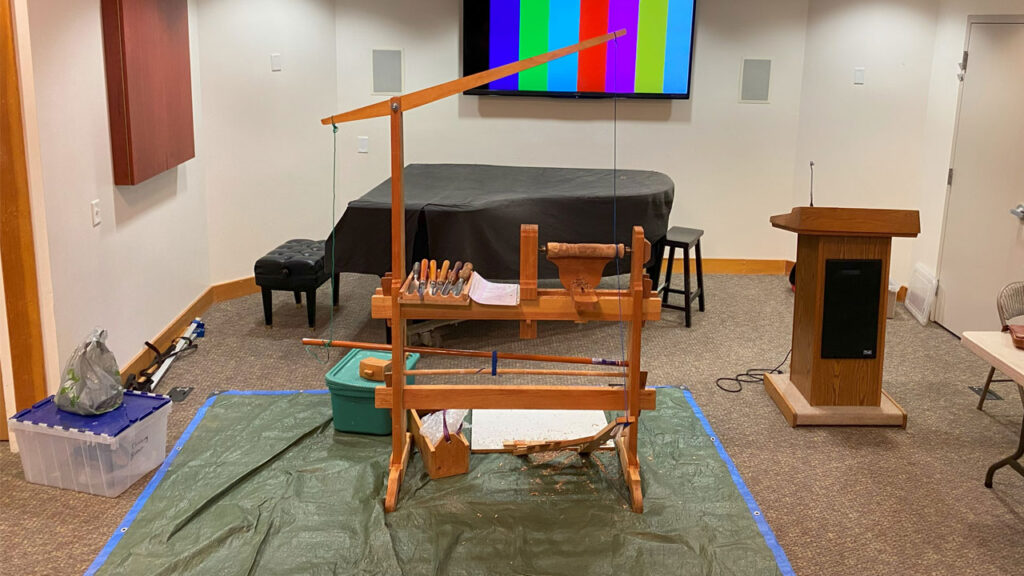
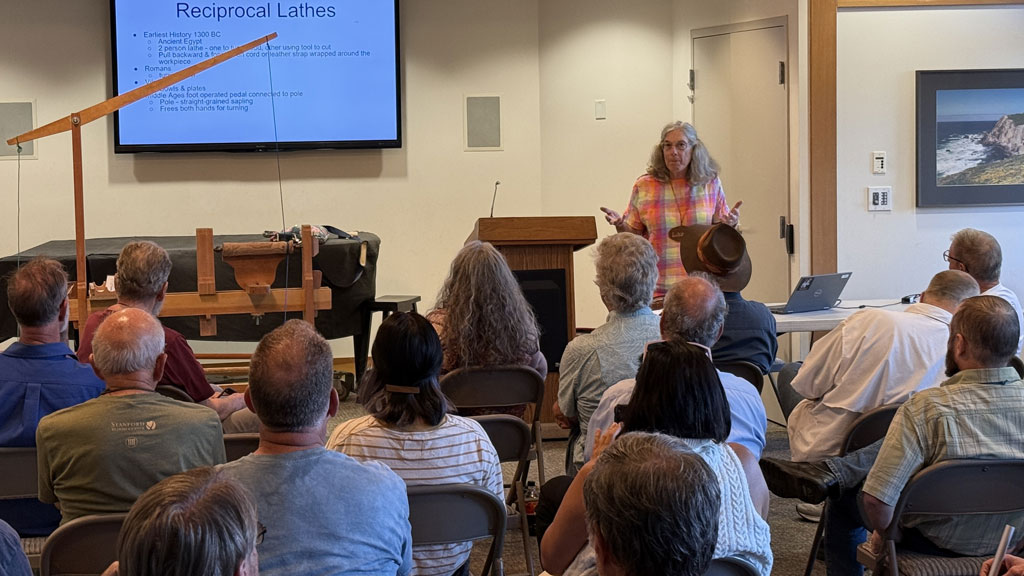
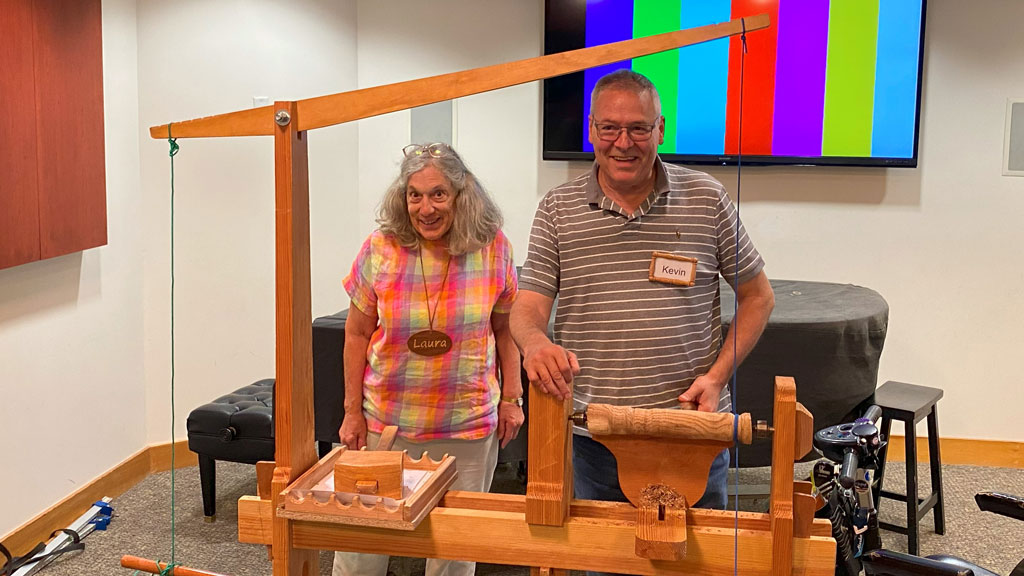
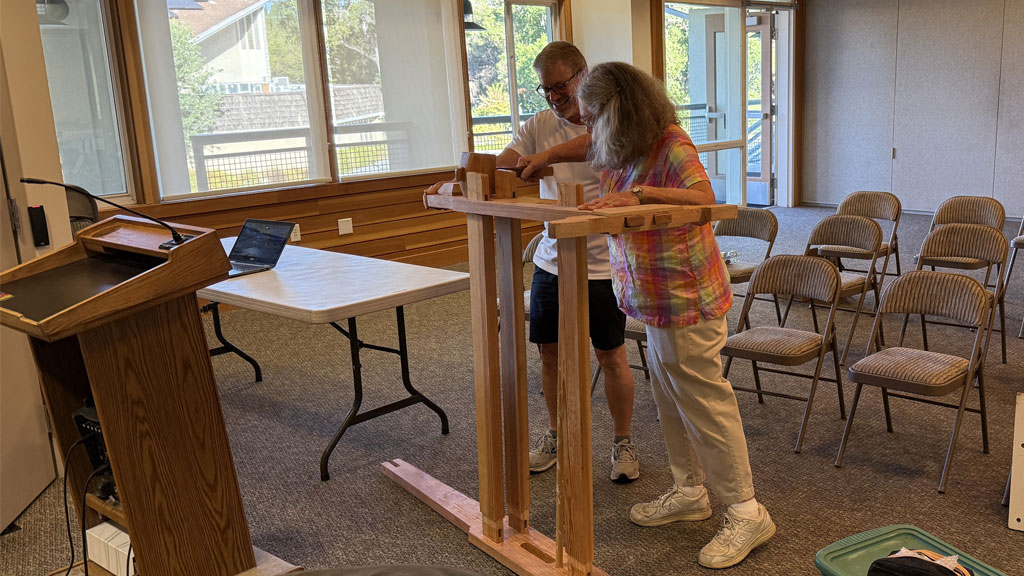
President’s Challenge: Turn and wear a name tag
Click on a picture below to enlarge it
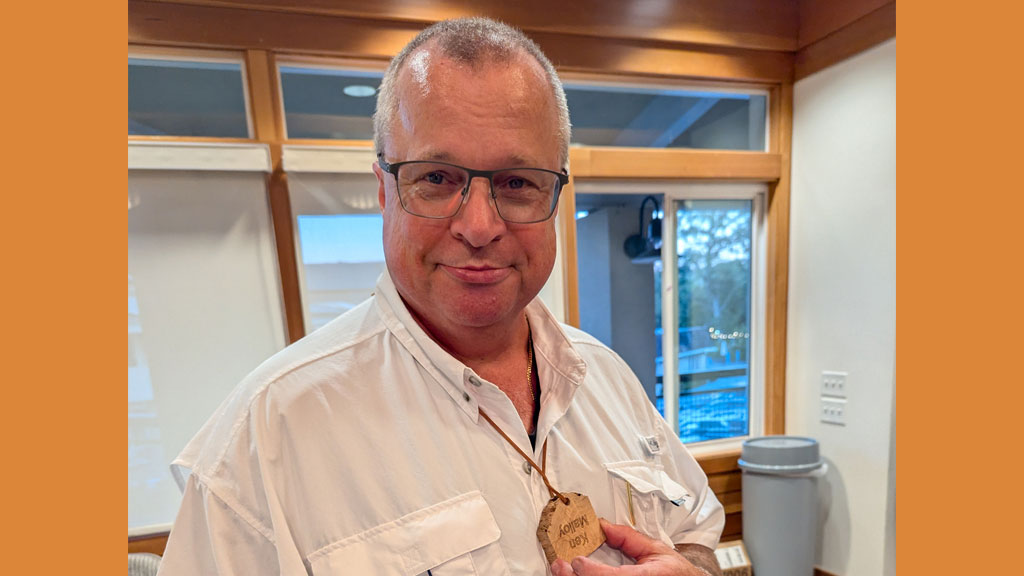

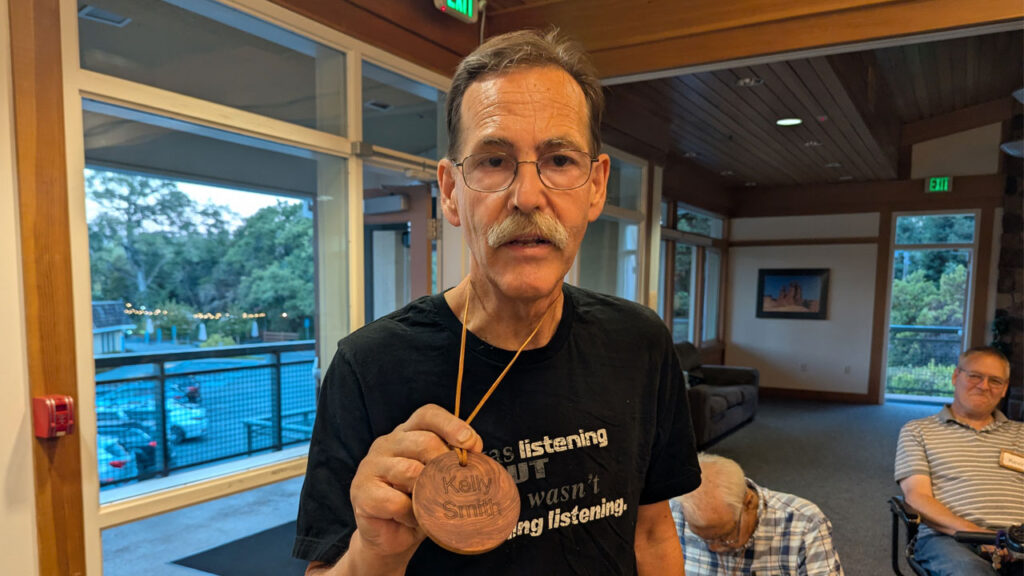
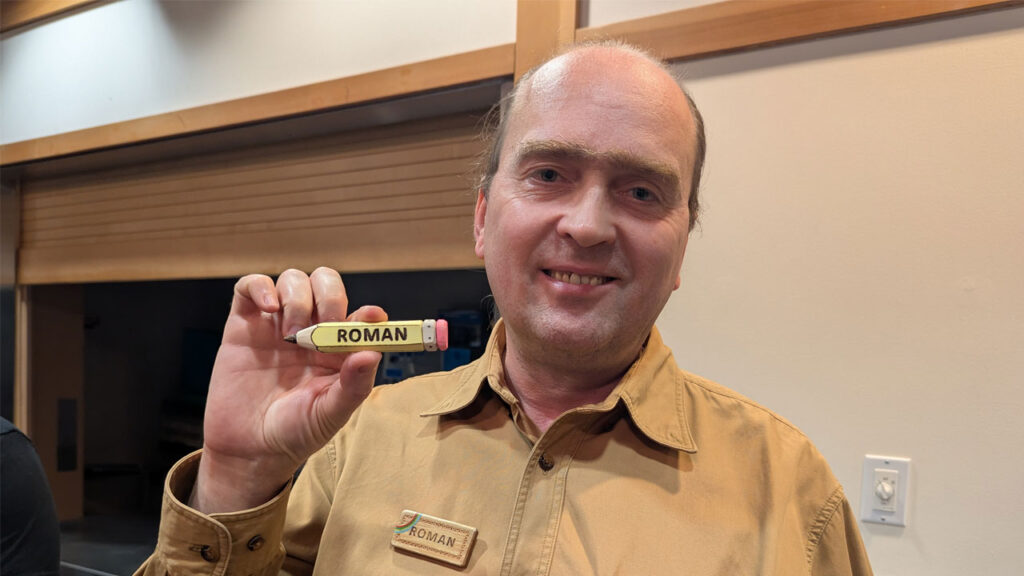




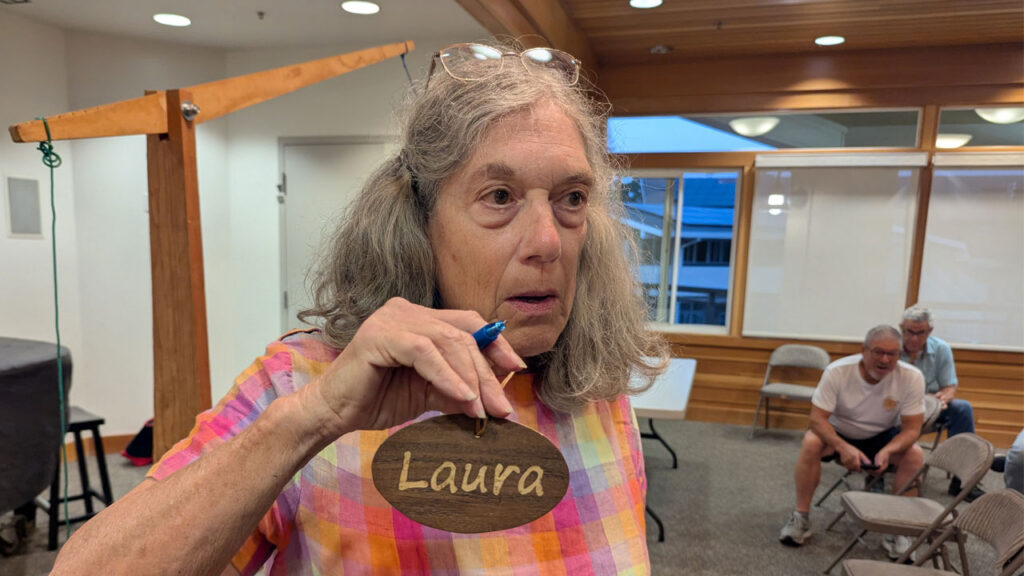







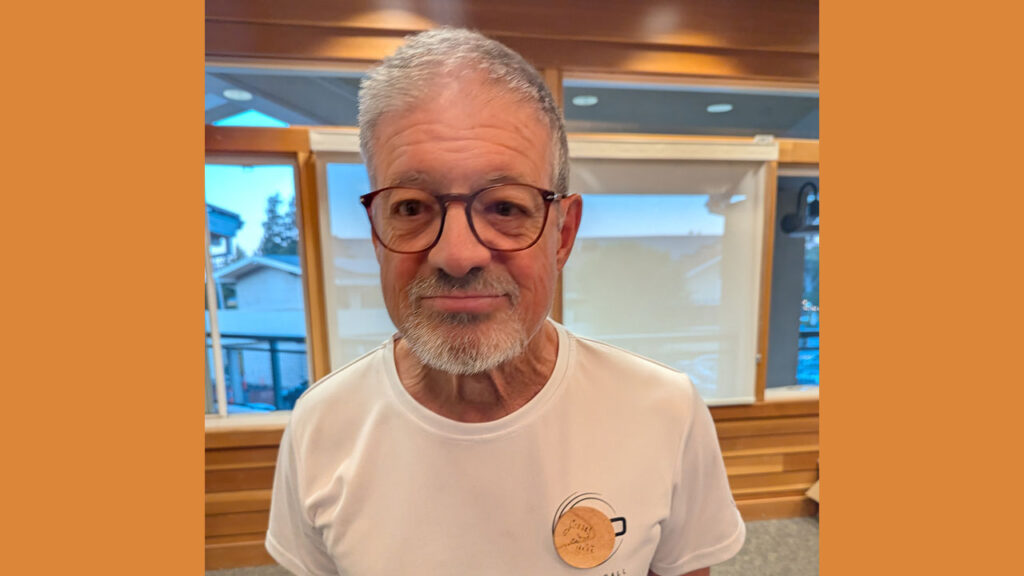

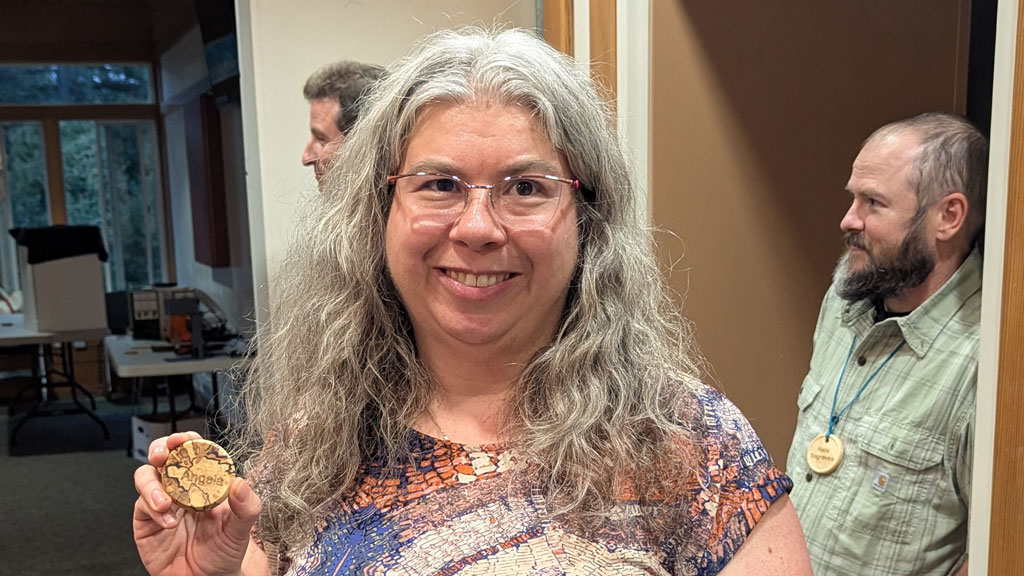

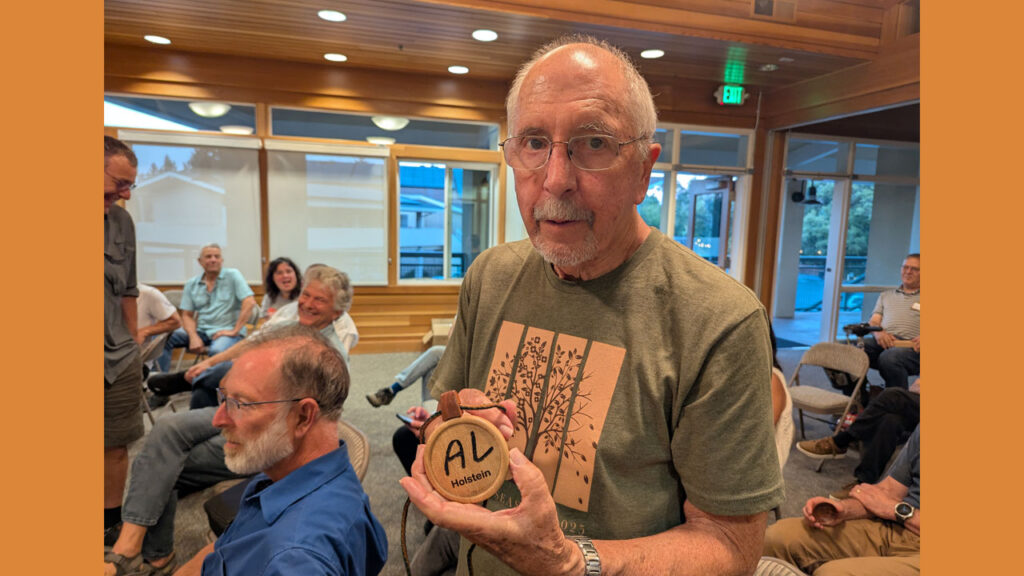



A big shout out to Nate Segraves, James Craig, and Edgar Whipple who brought in laser engraving equipment and helped members customize their turned nametags during the meeting.

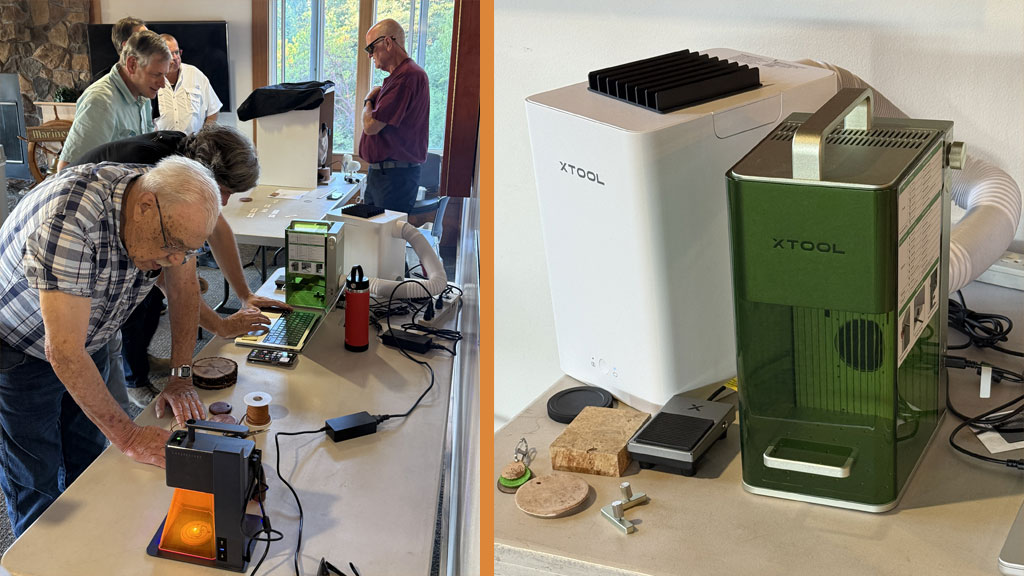
Many, many members showed off their nametags – either newly engraved during the meeting or previously created. Apologies to those I might have missed or didn’t catch the details.
Roman Chernikov’s hand-carved a pencil-shaped nametag featuring wood burning and acrylic paint.
Jerry Galli’s maple nametag is held in place with two magnets.
Bob Bley’s is made of lacewood.
Vic Mitnick made an olive nametag.
Harvey Klein showed off his nametag.
Al Holstein showed off his nametag.
Alison Lee used a modified club logo on her nametag.
Kelly Smith’s nametag was of Hollywood juniper.
Daniel Saal had an offcenter nametag.
Chip Krauskopf made a tiny bowl for his nametag.
Luana Staiger’s nametag was made of wood from the end of a log in her yard.
Dave Vannier showed three different nametags he had made over the years. One was made when he first joined the club, another was segmented, and the third was acrylic, laser-engraved.
Jon Sauer’s nametag was of African blackwood with a dot of bloodwood in the center.
Larry Maggi made a maple nametag.
Kevin Lee’s nametag features a spindle turned frame. He newly engraved a piece of wood and will cut it to size to fit into his existing frame.
James Craig’s nametag was burl.
Nate Segraves had a maple nametag.
Edgar Whipple showed off his nametag.
Angela Gunn’s nametag was made of a lovely piece of spalted birch from her firewood pile.
Laura Rhodes’ nametag was created using marquetry.
Show & Tell:

Jon Bishop showed a pair of lidded boxes made from Bay Laurel with a knob of African Blackwood. He also made a maple burl box.

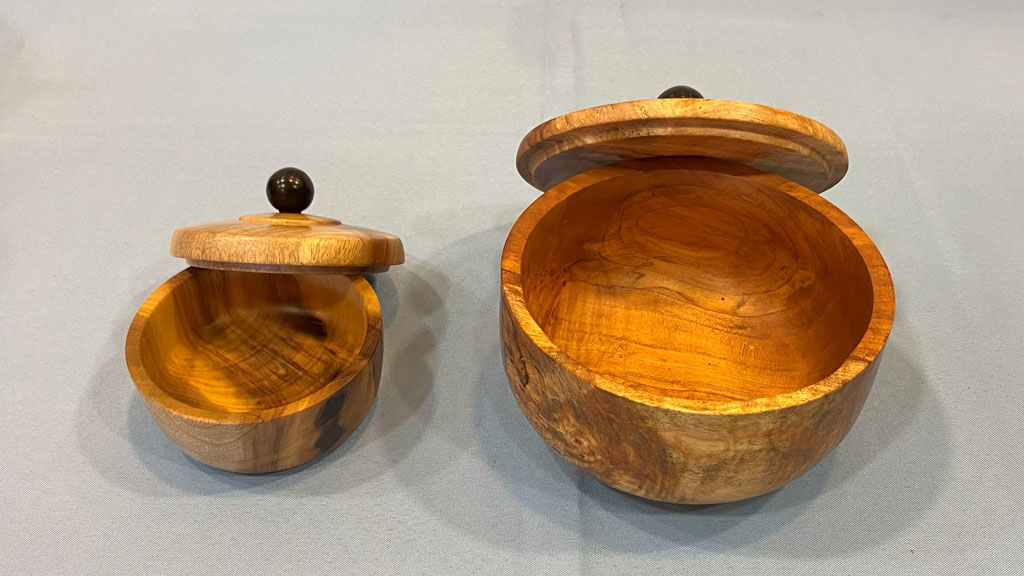
Dean Caudle showed a mahogany platter and a bowl with colored powder and CA glue in a groove. Dean also showed a 3D-printed compass extender made by one of the members of the Santa Cruz turning club.
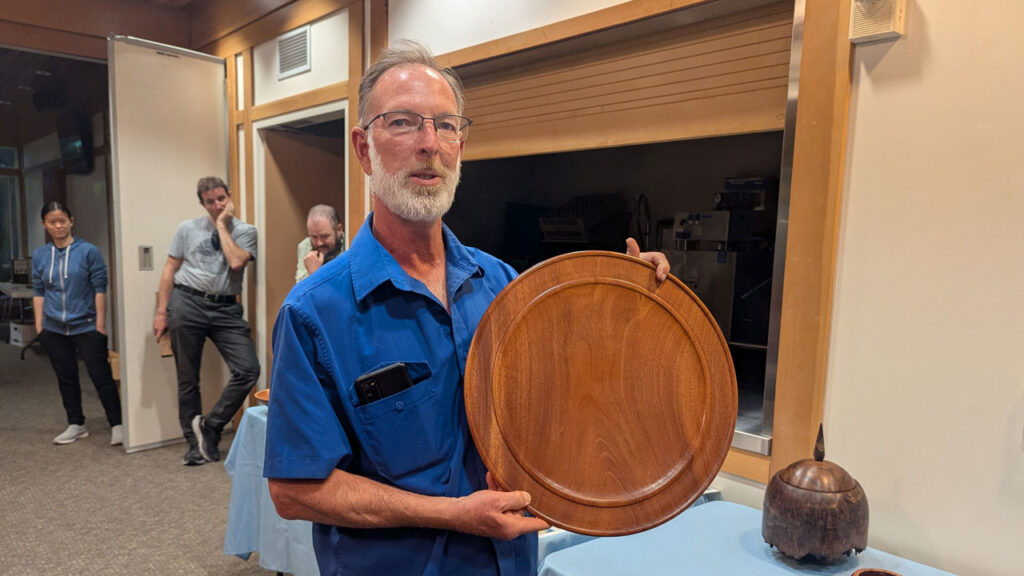


Jon Sauer brought in a couple of his old African blackwood boxes. One was made on a Rose engine lathe, the other on a Holtzapffel ornamental turning lathe.
Dave Vannier made a pair of square plates – one of mahogany, the other of walnut.
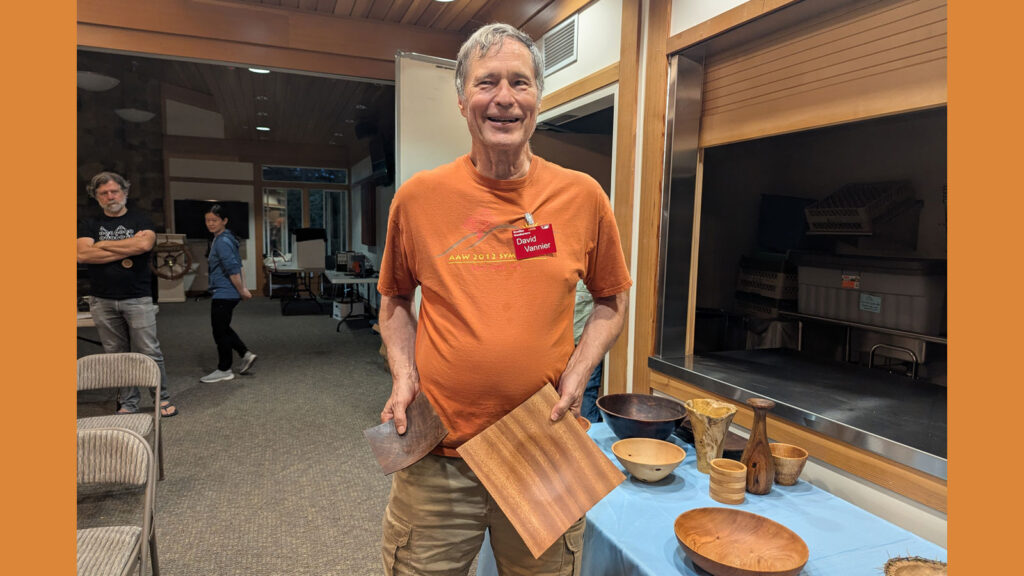



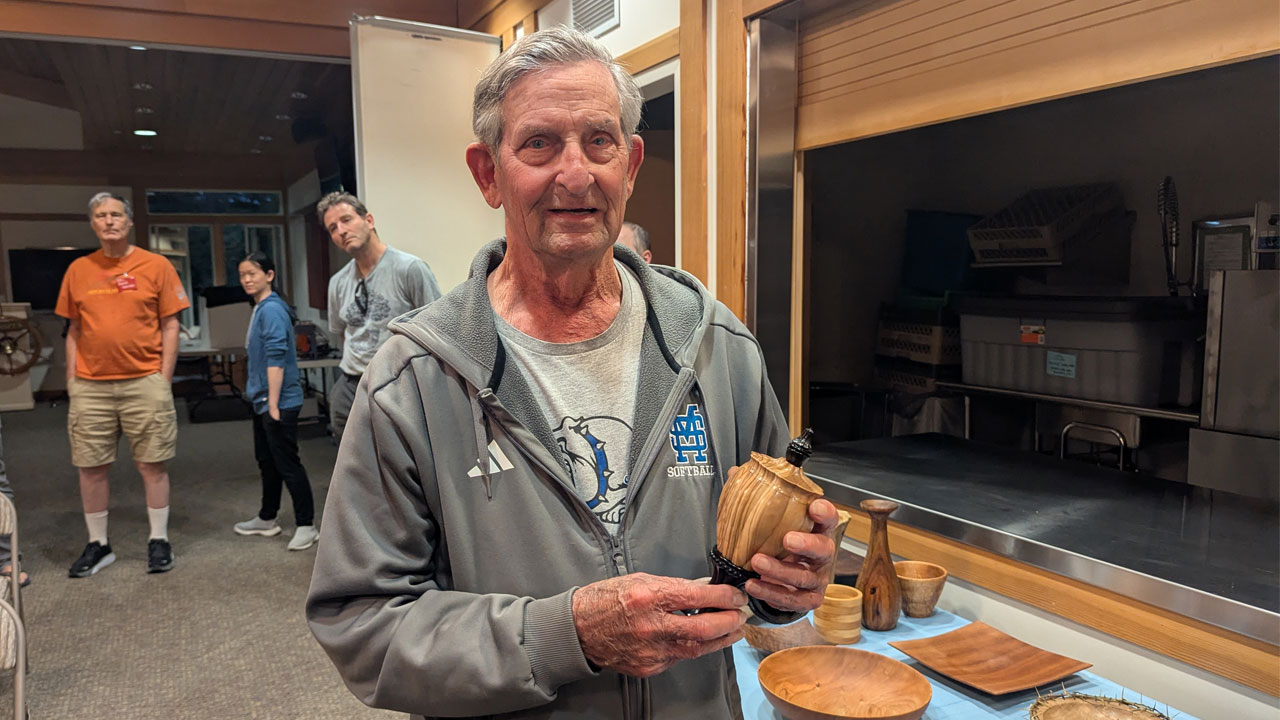
Dale Bassmann made a box of African blackwood and olive wood. He used both his Rose engine and his regular lathe. The inside of the box is carved like the outside. The box was finished with one coat of lacquer and wax.
Kelly Smith had a bowl made of eucalyptus, which Kelly likes to call “Widow Wood”. He showed some slippery red elm bark, a big bowl of unknown wood, a madrone bowl, a pencil cup of stacked maple, a whale-shaped vase made from a fruitless mulberry knot, a broadleaf maple bowl, and a eucalyptus winged bowl made from a gunstock blank.


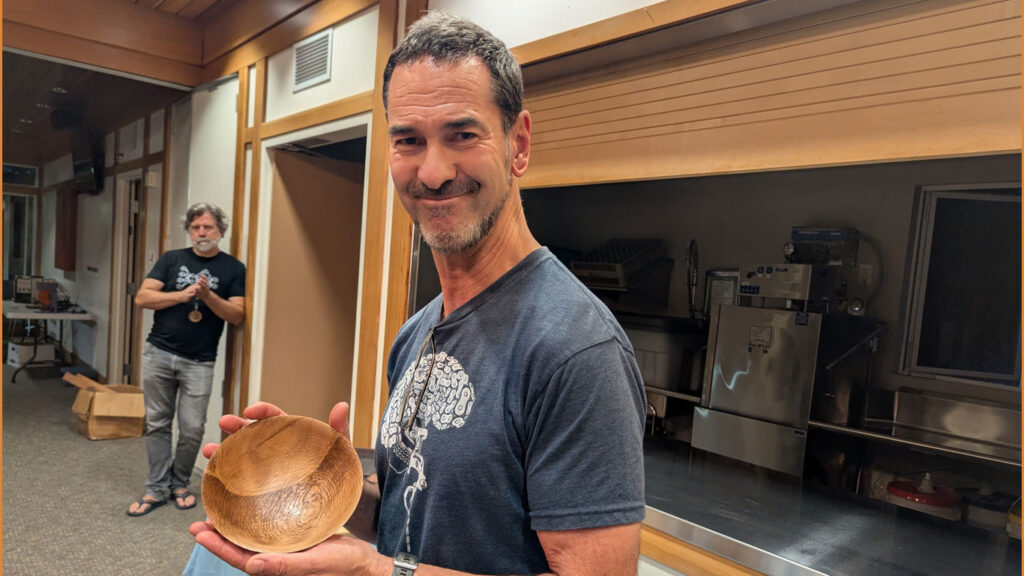
Chip Krauskopf made a bowl from coast live oak. It took him six months to make thanks to a skiing injury and subsequent physical therapy.
Daniel Saal made a bowl from a burl with a sweet aroma. He also had a closed-rim bowl finished with poly.

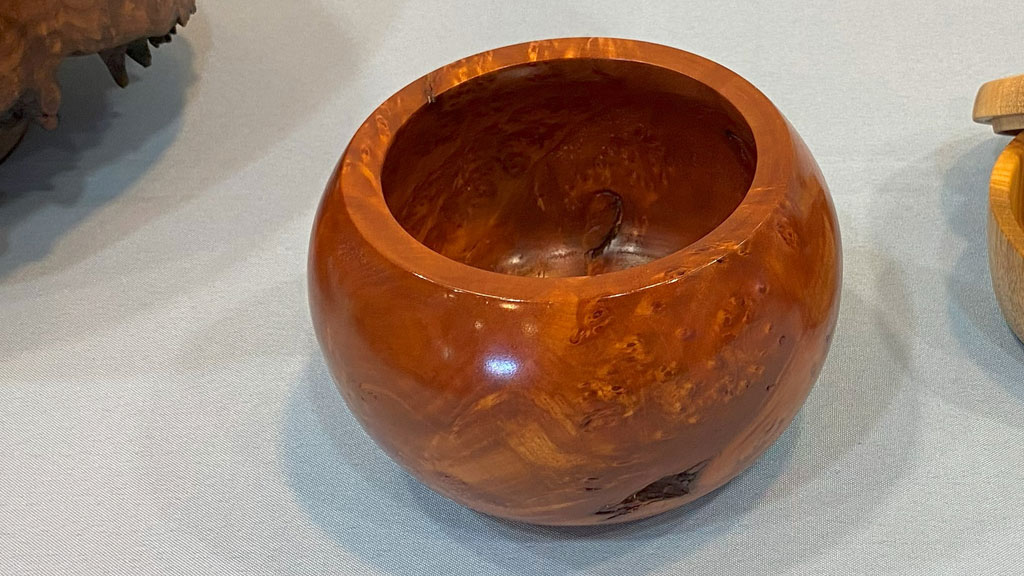
Nate Segraves was inspired by an Iranian turner on Instagram. He created a large box with the live edge along the bottom from a black walnut burl and finished with walnut oil. The pedestal was turned separately prior to attaching to the bowl. The underside of the bowl was very difficult to sand given both the sharp edges and delicate nature of the live edge.

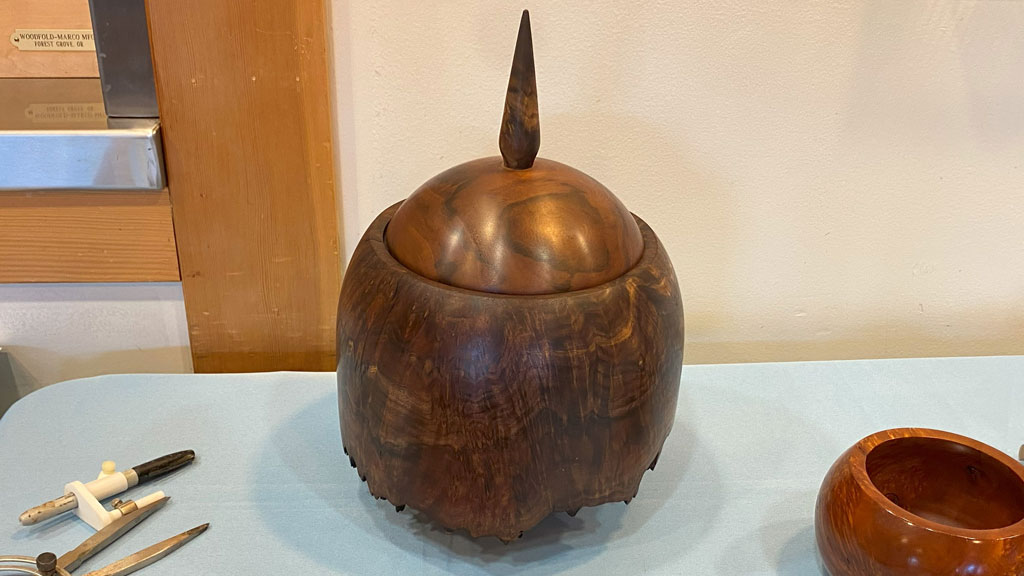
Al Holstein showed his “Grandpa’s Candy” dish made of unknown free wood with a rim trimmed with a wreath of bougainvillea trimmings (featuring their nasty thorns). He also showed a winged birch bowl with a natural edge.
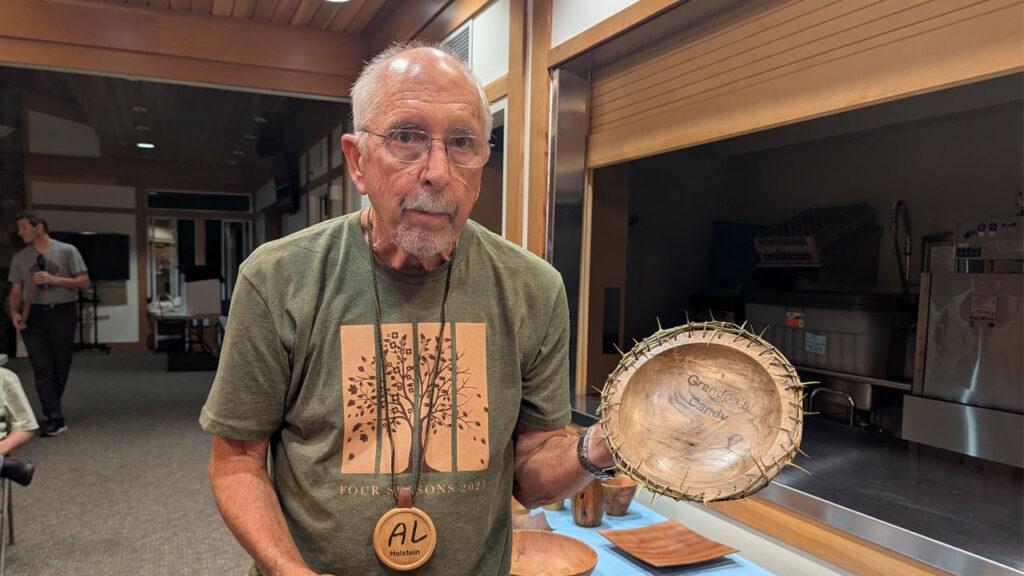

Other Projects
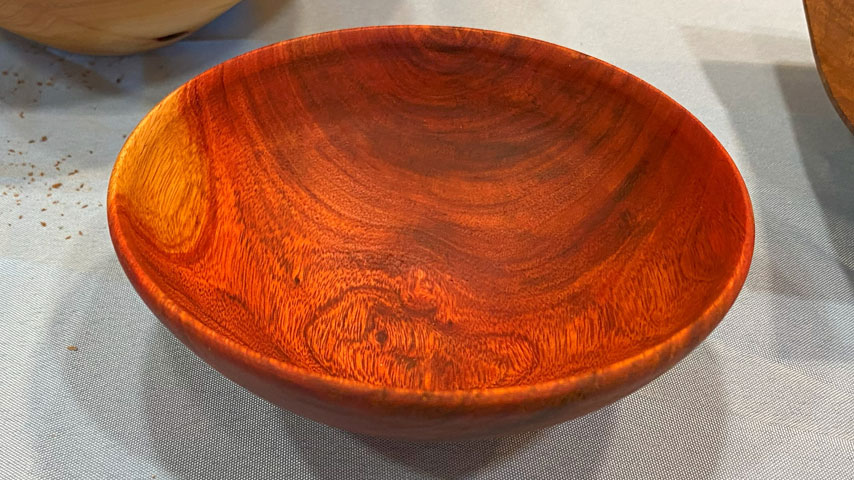
Who has turned this bowl? Please let Roman know so that we can give proper credit. Thanks!
Participation Prizes
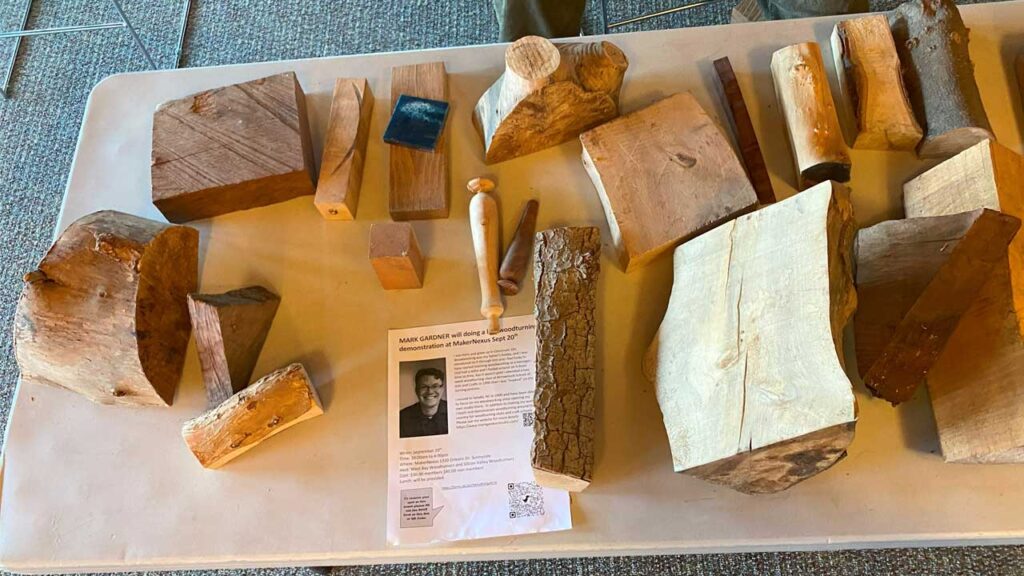
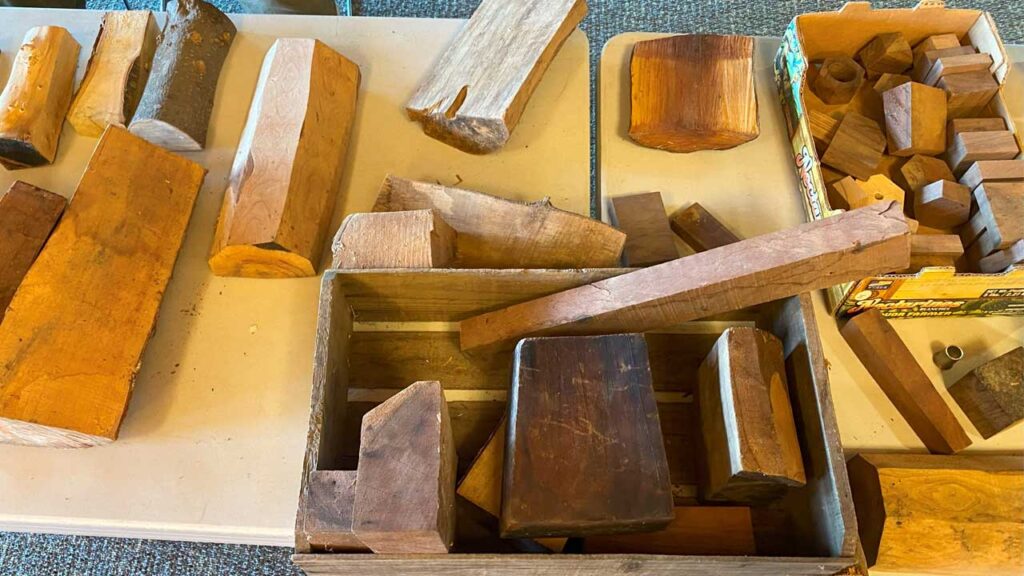
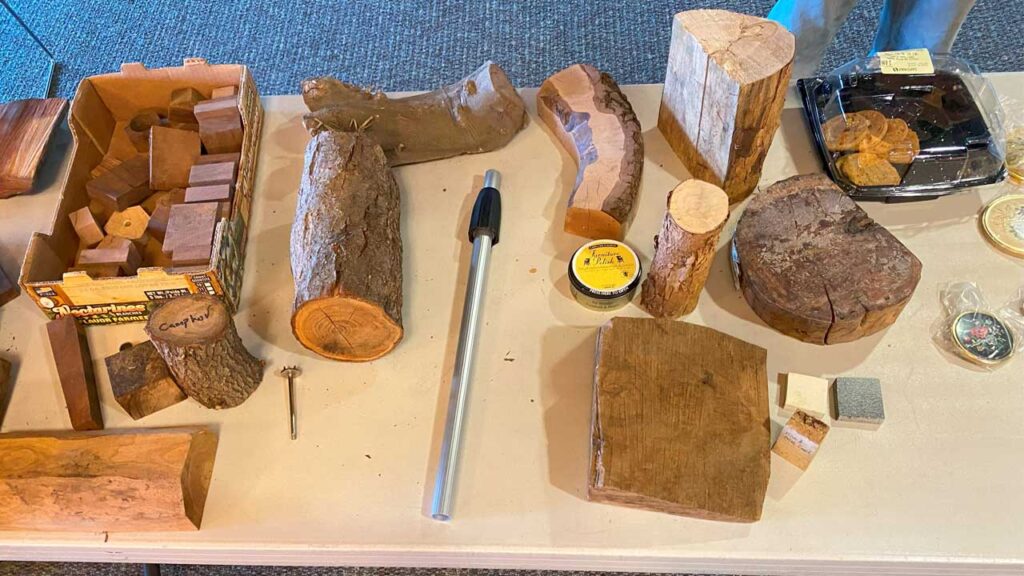
“As the Wood Turns” by David Vannier
This month I would like to pay my respects to David Ellsworth, acknowledging the impact he had on the woodturning world. For those of us that had the pleasure of spending time with him, this won’t sound unusual. For those of you that did not, hopefully this will help you understand why i feel the way i do, and understand how much he will be missed.
I first met David at the 2003 AAW Symposium in Pasadena. It was my first symposium, and i had only been turning for 3 years. I had focused on segmented turning, which allowed me to use my planning and woodworking skills, while I learned how to turn. I decided to make a large segmented piece to show at the instant gallery. I bravely signed up for an instant critique. David was one of the professionals which wandered through the gallery, stopping and giving feedback to anyone who asked. His feedback was positive, probably kinder than it should have been. But motivating. At the following club meeting, people were bowing down and treating me like i was someone special. Our club president, who did outstanding segmented work, just said i was really brave. I must have been the most confused person in the room. Turned out that my piece made the front page of the magazine, and i was told David did not like segmented work. I hadn’t gotten my magazine yet, so was completely caught off guard. We all had a good laugh.
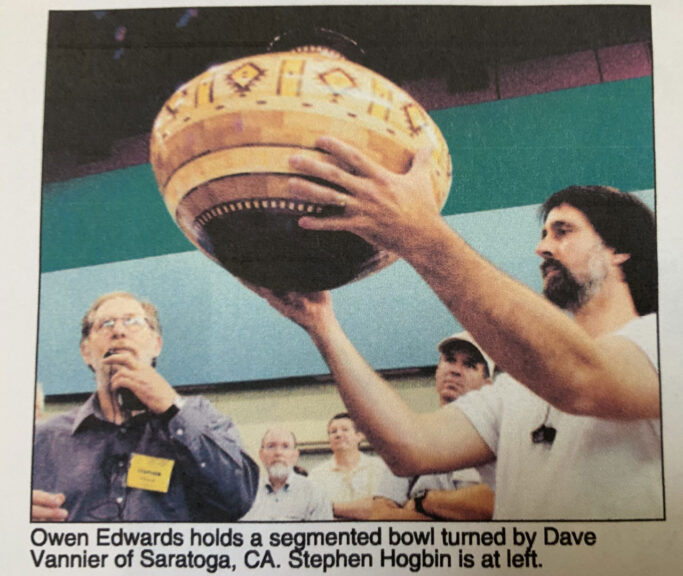
At the time, i didn’t really know who David was. As i was told, he was one of the founders of AAW, and played a significant role in setting the directions and how the symposiums operated. As part of my working career, i had given talks at major conferences, but have to say as an engineer, my talks were more marketing than technical. I was shocked that while i didn’t have the technical skills to create pieces that i saw, after sitting through a symposium session I had all the knowledge required to replicate the piece. As it turns out, David had set expectations with each demonstrator that they were to share everything, or not demonstrated. In a later meeting with him i asked about this. He felt very strongly that the art/craft would develop much faster through sharing rather than hiding. Over the years, i have really come to believe this. Sadly, I’ve been in a few sessions where this principle was not practiced. I hope that this is one off rather than a trend.
WBW had the privilege of having David give us an all day demo twice. Both were sold out sessions! I also had the pleasure of participating in a 3 day hands on class. I was allowed to use his tools, with lots of warnings that if i broke them i would be in big trouble. I didn’t, whee. Bob Bley and i took him out to dinner one night, sharing more stories and insights. His skills and vision is something i hope to achieve. I can’t say we were close friends, but i can say i had a great deal of respect for him. He promptly answered my emails with thoughtful responses, even on subjects that we did not agree. His leadership will be missed. Thank you David!
Woodturners Newsletter Editing Notes
WBW members, please let the newsletter editors know if you have a personal website and would like it included in the President’s Challenge and Show & Tell sections of our Woodturning Newsletter. Email us at info@westbaywoodturners.com.
WBW board members and committee chairs
President: Jon Bishop
Vice President: Tom Gaston
Treasurer: Jim Koren
Secretary: Laura Rhodes
Member at Large: Dean Caudle
Meeting Program Coordinator: Claude G acting
Visiting artist Coordinator: Dean Caudle acting
Anchor seal: Dennis Lillis
Craft Supply: Tina Chou
Librarian: Kelly Smith
Audio Visual: Curtis Vose, Edgar Whipple
Website: Roman Chernikov
Woodturners Newsletter: Angela, Jon, David, Laura, and Roman
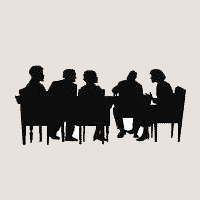

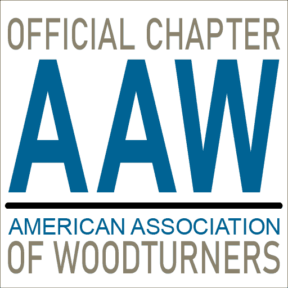

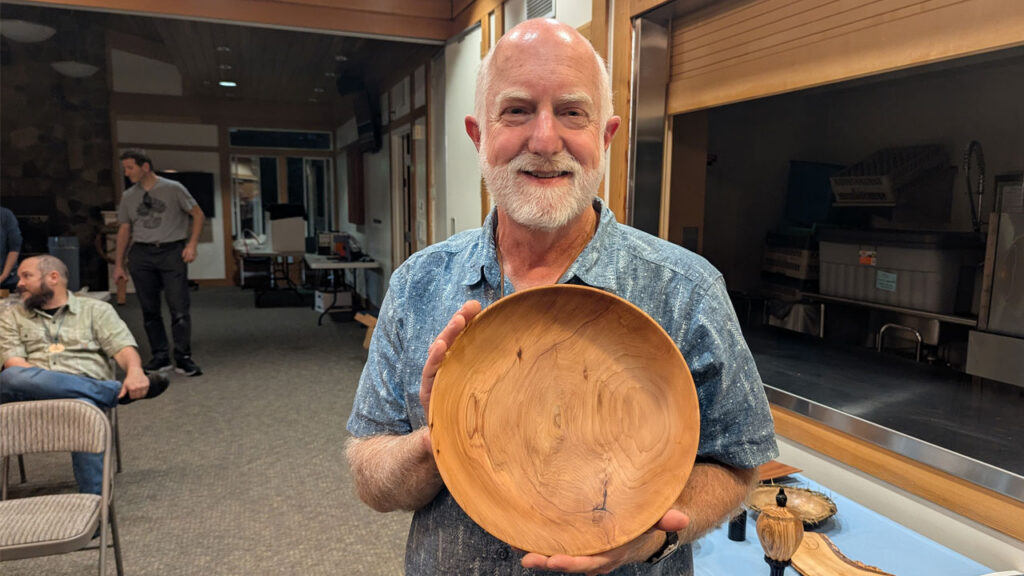
Leave a Reply
You must be logged in to post a comment.